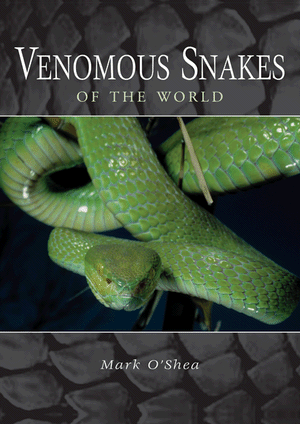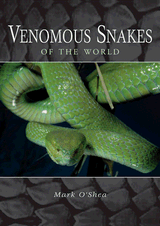| A Q&A with author Mark O’SheaWhat most attracted you to herpetology?
I’ve been interested in reptiles and herpetology from the age of 8 or younger! May be it had something to do with the fact most other people preferred ‘furries’ and turned away from reptiles. I simply became fascinated by these diverse and highly successful creatures which survived and even thrived in a four-legged warm-blooded world. Which species of snake do you regard as the most dangerous you’ve encountered? The most dangerous snake is not the most venomous. The most venomous snakes are taipans, Australian brownsnakes and seasnakes but they have small venom yields and few snakebites to humans and few human fatalities in the scheme of things. Australia suffers 2-3 death a year but around the world 40,000-100,000 people die of snakebite (I have explained this in the venoms section of the Venomous Snakes of the World). Any highly venomous snake is dangerous if it bites you, irrelevant of whether it is the most venomous or the one responsible for most deaths, only one bite matters at that time, the one you just received, so with that in mind I have encountered many many dangerous snakes from rattlers to cobras, seasnakes to desert vipers but I regard the most dangerous snake I have encountered to be the Sri Lankan Russell’s viper which featured in my film “Venom”. What are the most common mistakes people make when bitten by a venomous snake? What are the essential things to do if bitten? I have always said the DO NOTs are often more important that the DOs in snakebite first aid because it is often the ill-advised attempts and misguided actions following snakebites that make the situation worse. For example:
What to do depends on what snakes are in the area but they include immobilization of the bitten limb, immobilization of the patient and transportation directly to medical help or the mobilization of medical help to come to the victim, reassurance of the victim and maintenance of consciousness, application of a pressure bandage (Aussie bandage) in the case of purely neurotoxic snakebites, maintenance of airway and clearance of excessive saliva, monitor vital and neurological signs and preparation to artificially ventilate or begin CPR if necessary. As for the snake, if it can safely be killed and placed in a solid container (not a bag) and transported to hospital with the patient for later examination by a qualified person, that should be done but further bites should not be risked in the process and the snake should be handled only with a stick as ‘dead’ or dying snakes have still administered fatal snakebites. If the snake cannot be caught then a description (size, color, pattern, shape, location, behavior, strike) should be noted and written down from witnesses and the victim which is still fresh in their minds. Which venoms are most useful medicinally? Malayan pitviper venom has been used in a cardiac surgery drug to prevent coagulation occurring post-surgery. Venoms may be pro-coagulant, anti-coagulent, heamorrhagic, pre- and post-synaptic neurotoxins, tissue-destroying, etc. There are many potential and practiced uses. Do you personally work with the extracted venom? I have done a great deal of venom extraction but I pass the venom on to others such as Liverpool School of Tropical Medicine. I do not work in a venom lab and I am not a biochemist. I am a “whole-animal biologist.” I am interested in the snake in its environment with its habitat, predators, prey, parasites, and competitors. What is the greatest benefit, personally and/or professionally, from studying these snakes? There have been many. I believe we live to learn and when we feel we know everything we may as well quit. To discover something new, some small fact, is very exciting and I am continually thrilled by this experience, which is why I prefer to work on wild, rather than captive, reptiles. I have been honored with the Explorers Club (British Chapter) Millennium Award for Service to Zoology and a Doctor of Sciences degree for my contributions, I have also been honored by a king cobra who waited for me to turn to face her before fixing me with her eyes and swaying as I am sure she asked me “Why did you catch me?” I have had some many incredible experiences through my interest in reptiles that I could not begin to list them all, even the snakebites have taught me something, if only to move quicker next time. Which species suffers the most from human encroachment? Island species are safe and isolated from what happens on the mainland but when something untoward, man-made or natural, occurs on the island they are threatened with total destruction with little chance of recolonization. Islands may be surrounded by sea as in the traditional sense, but populations on rocky outcrops in the desert, or elevated cliffs or tepuis in rainforest country may be just as vulnerable. Also at risk are species in areas desired by man for development. I listed many threatened venomous snakes, and the reasons for concern in the Conservation section in the book. Over collection, introduction of livestock or intensive agricultural practices are all threats. Which species is the rarest venomous snake? Hutton’s pitviper (Tropidolaemus huttoni) is known from only one preserved specimen from the Western Ghats of India but there are others that were more common but are now in decline such as the Mangshan pitviper (Zhaoermia mangshanensis) in China. Many are threatened or endangered. Can you talk more about your choice to categorize the snakes regionally rather than taxonomically? The usual and easiest route was taxonomically but I liked the geographical approach in the New Holland book on Rainforests and thought the approach, when applied to venomous snakes, challenging. It was that it caused endless problems for me in the early stages but I did not want to go down the time-honored taxonomic route and wanted to make it work, believing non-reptile specialist people would like to read about the snakes of the same geographical area in the same chapter, rather than have to sift through four chapters to find out about African boomslang, stiletto snake, black mamba and puff adder. What has emerged as the positive aspects of snake nature in your research? I hope my work can lead to a greater understanding of the importance of even venomous snakes, hopefully leading to fewer being killed unnecessarily or out of ignorance. It is not a crime to be a snake, even a venomous one, and we were not put here to extinguish snakes from the world. I would also hope my venom collection and fieldwork and my highlighting concerns about a looming antivenom crisis, may lead to development of cheaper and more easily available antivenom for the poorer countries. Snakebites only kill a small number compared to malaria or AIDS but production and availability of antivenom worldwide would bring that number down and save many lives. |
TEN DEADLIEST SNAKES IN THE WORLD
300.00৳
Delivery system
===============
Face to face from our office
Download from Dropbox link
Courier Service
Payment system
==============
Face to Face
bkash-01716197088
Contact
========
01919197088
01716197088-bkash
01552551768-office
qrtzcom@gmail.com
www.quartzbd.com
www.facebook.com/quartz.bd











Reviews
There are no reviews yet.